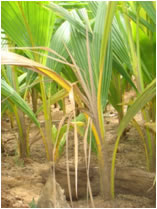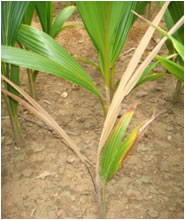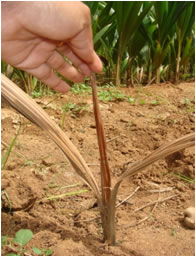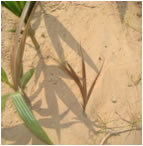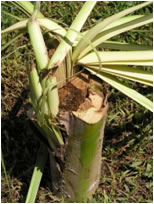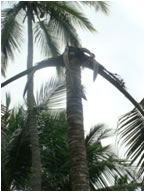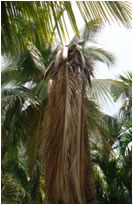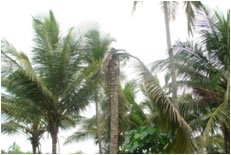
| Germination to seedling stage |
| Parts affected | Symptoms |
Management |
Image |
| leaves and stem | • Growing tip eaten way by the temites |
• Locate termite mounds in or near the coconut nursery or garden and destroy. • Spray chlorpyriphos @ 3ml/lit of water, neem oil 5% or • NSKE 20% to preserve plaited coconut leaves from the termite attack. |
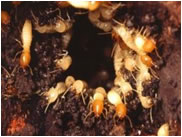 |
| Parts affected | Symptoms |
Management |
Image |
| roots | • Grubs feet the tender roots and tunnel into the bole of the collar region resulting in drying and yellowing. | Mechanical Method: • Set up light trap @ 1 / ha or bonfire. Chemical Method: • Soil application: Malathion 5 D or endosulfan 4D 25 kg/ ha at the time of planting (Treat the soil with phorate 10G @ 100 g/palm or drench with chlorpyrifos 0.04% suspension. The treatment should be given twice, first during April-May after the receipt of pre-monsoon showers and second during the month of September). |
| Parts affected | Symptoms |
Management |
Image |
| seedling | • Damage to seeds and seedlings in nurseries by rats and squirrels. • Stunted growth and drying up of seedlings and trees due to Chewing and nibbling of the roots of saplings and young trees. • Chew through the collar into the crown and kill young plants of coconut, this type of damage is the main cause of loss and it involves damage to coconut. |
• A clean environment discourages rodents from establishing in an area. • Reduction in bund thickness and height discourages them from burrowing. • Acute Rodenticides: Zinc phosphide, aluminium phosphide @ 2 tablets per hole |
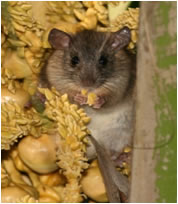 |
| Parts affected | Symptoms |
Management |
Image |
| Roots | • Damage the roots of coconut. • The nematode survives in roots of felled trees up to six months. • Elongated orange colour lesions are seen on tender and semi hard roots. • Lesions enlarge and coalesce to cause extensive rotting of roots in consequent to nematode parasitization and multiplication. • Tender roots become spongy in texture on heavy infestation. |
Biological Method:
Cultural Method:
|
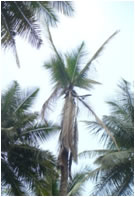 |
| Parts affected | Symptoms |
Management |
Image |
| Leaves, buds, young nuts | • Fungus enters into plant by infecting tender host tissues (leaves, buds or young nuts). Affected leaves turn yellow and later brown. The heart leaf becomes chlorotic, wilts and collapses. it can be pulled out easily. • Disease spread to older, adjacent leaves and spathes, producing a dead centre with a fringe of living leaves. • Light brown to yellow, oily, sunken lesions may be found on leaf bases, stipules or pinnae. • Internally, the tissues beneath the bud are discoloured pink to purple with a dark brown border. Affected leaves progressively drop. Infected nuts show brown to black necrotic areas with a yellow border developing on the surface; internally, they have a mottled appearance. • Young nuts are highly susceptible and fail to mature, they then fall off the tree and older infected nuts ripen normally. |
Cultural Method: • Provide adequate drainage in gardens. • Adopt proper spacing. • Avoid over crowding in bud rot prone gardens. Chemical method : • Remove the affected tissue of the crown region and drench the crown with 0.25% Copper oxychloride. • Spray 0.25% Copper oxychloride on the crown of the neighbouring palms as a prophylactic measure before the onset of monsoon. • Spray with Copper oxychloride 0.25% after the onset of Monsoon. |
|
| Parts affected | Symptoms |
Management |
Image |
| leaves | • Droopiness of leaflets is the characteristic symptom. • Yellowing of leaf tips to the middle of the leaves, necrosis of leaflets. • Deterioration and decay of root system. • The leaflets curve inward to produce ribbing so that the whole frond develops a cup like appearance. |
|
| Parts affected | Symptoms |
Management |
Image |
| Leaves | •yellow undersized leaves
|
• Application of recommended nitrogenous fertilizers (69kg of Urea/acre) or foliar application of Urea 20gm-40gm/lit water at fortnightly intervals. |
| Young plant Stage I |
| Parts affected | Symptoms |
Management |
Image |
| Leaves, Roots and trunk | • Wilting of seedlings • Roots eaten away by termites. |
Cultural Method: • Apply calcium at the base of the trunk for control of termite attack. • Swabbing with neem oil 5% once on the base and upto 2 m height of the trunk. |
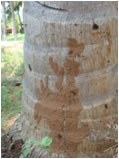 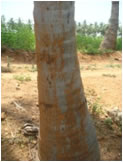 |
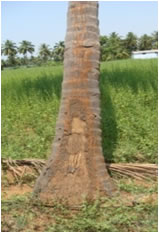 |
| Parts affected | Symptoms |
Management |
Image |
| leaves | • Dried up patches on leaflets of the lower leaves, only three or four youngest leaves at the center remain green. • Galleries of silk and frass on underside of leaflets. • Whole plantations present a scorched appearance in case of severe infestation. |
Cultural Method: Root feeding : • Secure the bag tightly to the root with a cotton thread. • After twenty four hours, check whether there is absorption or not. Select another root when there is no absobtion. This method should not be resorted to as a routine practice and it is suggested only for cases of severe epidemic outbreak of the pest and when the survival of the tree is threatened. Stem injection: |
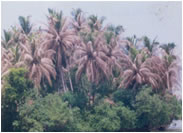 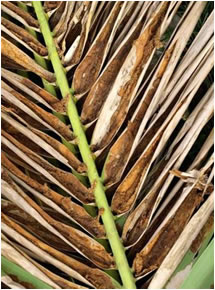 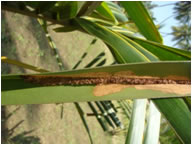 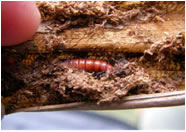 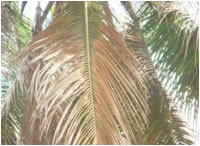 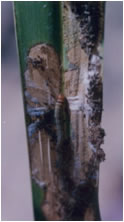 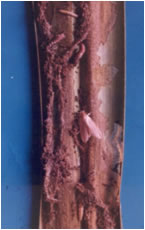 |
| Parts affected | Symptoms |
Management |
Image |
| Leaves | • Leaves turn yellow. • Premature nut shedding. • Flowering delayed. • White grubs are exposed when base of the tree dug. |
Cultural method:
Mechanical Method:
Chemical Method:
|
| Parts affected | Symptoms |
Management |
Image |
| leaves | • Young larvae feed on the lower epidermis of the leaf. • As they mature, the whole leaf blade is eaten leaving the midribs. • In heavy infestation, the larvae may defoliate the palm. |
Mechanical Method:
|
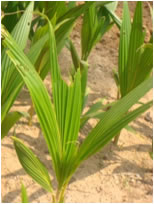 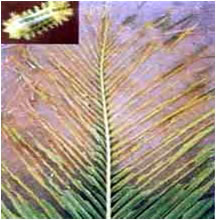 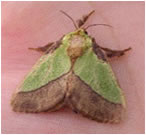 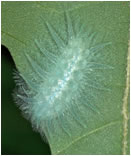 |
| Parts affected | Symptoms |
Management |
Image |
| leaves | • It feeds on plant sap. • Button mealy bugs colonize under the perianth lobes of tender nuts. Infested nuts harbouring gravid mealy bugs remain on the spadix, which serve as inoculum for further spread. |
Cultural Method:
Chemical Method: Spray any one of the following
|
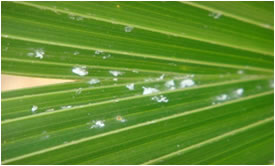 |
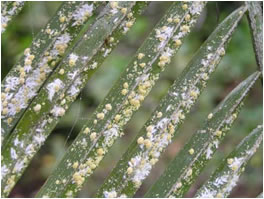 |
|||
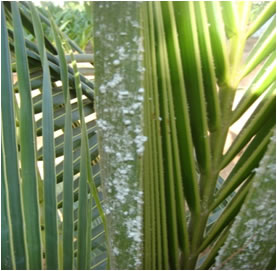 |
| Parts affected | Symptoms |
Management |
Image |
| leaves and nuts | • It occurs more in summer, it affects leaves and nuts of coconut palms. • At severe infestation, scale forms a continuous crust over flower spikes, young nuts and lower surface of leaves. • Yellow spots on leaves. • Entire leaves turn yellow to brown and falls. • Infested coconut fronds exhibit yellow areas on the upper surface, formed by numerous yellow spots each marking the position of the coconut scale on the under surface. Development of sooty mould. • Affected coconut palm turns bright yellow colour which is clearly visible from distance. • In extreme cases, the leaves dry out, entire fronds drop off and the crown dies. • Heavy infestation results in stunting of new leaves, reduction of crop yield or complete crop failure. |
Biological Method:
|
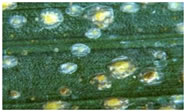 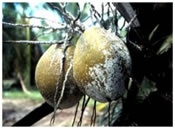 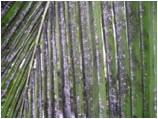 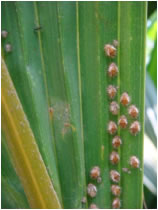 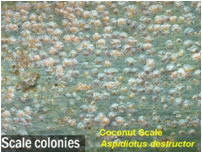 |
| Scales on leaf and tender coconut |
| Parts affected | Symptoms |
Management |
Image |
| leaves and trunk | • The adult beetle bores into the unopened fronds and spathes. Damage by the pest leads to 10 to 15% loss in yield. • The attacked frond shows characteristic triangular cuts when fully opened. • Central spindle appears cut or toppled. • Fully opened fronds showing characteristic diamond shaped cuttings. • Holes with chewed fibre sticking out at the base of central spindle. |
Cultural Method:
Chemical Method:
|
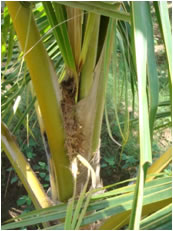 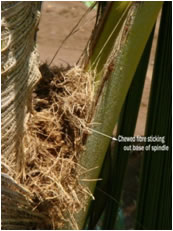 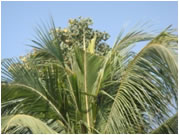 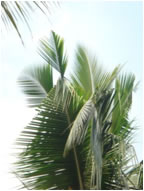 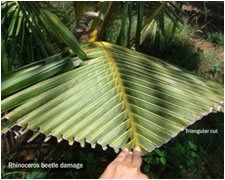 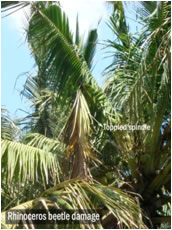 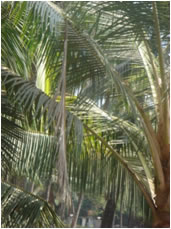 |
| Parts affected | Symptoms |
Management |
Image |
| trunk | • Make holes on trunk and hole can be seen on the stem with chewed up fibres protruding out. • Oozing of reddish brown liquid from the hole. • The grubs cause damage inside the stem or crown by feeding on soft tissues and bore into the soft, growing parts. • Inside portion of trunk is completely eaten and become full of rotting fibres in case of severe infestation. • In case of young palms the top withers while in older palms the top portion of trunk bends and ultimately breaks at the bend (wilting). • Sometimes the gnawing sound produced by the feeding grubs inside will also be audible. • In the advanced stage of infestation yellowing of the inner whorl of leaves occur. The crowns falls down or dry up later when palm is dead. |
Cultural Method:
Trap Method:
Chemical Method:
|
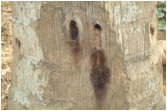 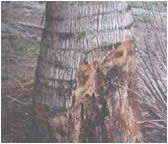 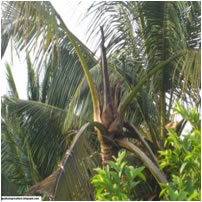 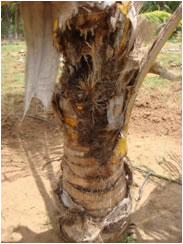 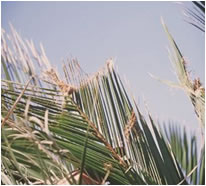 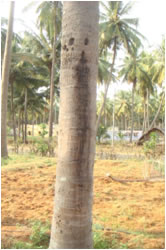 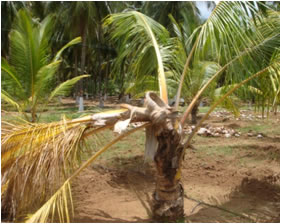 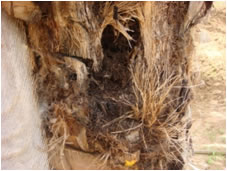 |
| Parts affected | Symptoms |
Management |
Image |
| Leaves, petioles, twigs, branches and fruits. | • Spear becomes pale and breaks at the base and hangs down. • Rotting slowly progresses downwards, finally affecting the meristem and killing the palms. This is accompanied by drooping of successive leaves. • Even then, nuts that are retained on the palm may grow to maturity. • The disease is fatal if not checked at the early stages, before damage of the bud. |
|
| Parts affected | Symptoms |
Management |
Image |
| leaves | • Droopiness of leaflets is the characteristic symptom. • Yellowing of leaf tips to the middle of the leaves, necrosis of leaflets. • Deterioration and decay of root system. • The leaflets curve inward to produce ribbing so that the whole frond develops a cup like appearance. |
|
| Parts affected | Symptoms |
Management |
Image |
| leaves | • This disease is a fungal complex initiated predominantly by Colletotrichum gloeosporioides, Exserohilum rostratum and Fusarium spp. • Spear fails to unfurl when disease is acute. |
Physical Method:
Chemical Method:
|
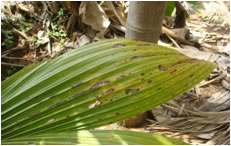 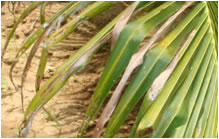 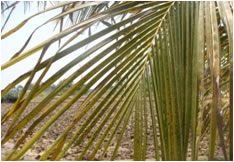 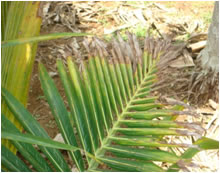 |
| Parts affected | Symptoms |
Management |
Image |
| leaves | • Minute yellow spots encircled by grayish bands appear on the surface of mature leaves of the outer whorl. • Later they become grayish white. These spots coalesce into irregular necrotic patches. • Complete drying and shriveling of the leaf blade at severe infection. |
Physical Method:
|
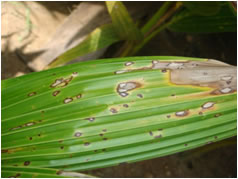 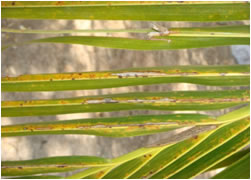 |
| Young Plant Stage II(5 to 20 years old - 1.Flowering, 2.Fruiting, 3.Ripening and Harvesting) |
| Parts affected | Symptoms |
Management |
Image |
| leaves and trunk | • Wilting of seedlings • Roots eaten away by termites. |
Cultural Method: • Apply calcium at the base of the trunk for control of termite attack. • Swabbing with neem oil 5% once on the base and upto 2 m height of the trunk. |
  |
| Affected shoot and panicle | |||
 |
| Parts affected | Symptoms |
Management |
Image |
| leaves | • Dried up patches on leaflets of the lower leaves, only three or four youngest leaves at the center remain green. • Galleries of silk and frass on underside of leaflets. • Whole plantations present a scorched appearance in case of severe infestation. |
Cultural Method: • Secure the bag tightly to the root with a cotton thread. • After twenty four hours, check whether there is absorption or not. Select another root when there is no absobtion. This method should not be resorted to as a routine practice and it is suggested only for cases of severe epidemic outbreak of the pest and when the survival of the tree is threatened. Stem injection: |
  |
| Affected shoot and panicle | |||
     |
| Parts affected | Symptoms |
Management |
Image |
| leaves and nuts | • Leaves turn yellow. • Premature nut shedding. • Flowering delayed. • White grubs are exposed when base of the tree dug. |
Cultural method:
Mechanical Method:
|
| Parts affected | Symptoms |
Management |
Image |
| leaves | • Young larvae feed on the lower epidermis of the leaf. • As they mature, the whole leaf blade is eaten leaving the midribs. • In heavy infestation, the larvae may defoliate the palm. |
Mechanical Method:
|
    |
| Parts affected | Symptoms |
Management |
Image |
| leaves | • It feeds on plant sap. • Button mealy bugs colonize under the perianth lobes of tender nuts. Infested nuts harbouring gravid mealy bugs remain on the spadix, which serve as inoculum for further spread. |
Cultural Method:
Chemical Method: Spray any one of the following
|
   |
| Parts affected | Symptoms |
Management |
Image |
| leaves and nuts | • It occurs more in summer, it affects leaves and nuts of coconut palms. • At severe infestation, scale forms a continuous crust over flower spikes, young nuts and lower surface of leaves. • Yellow spots on leaves. • Entire leaves turn yellow to brown and falls. • Infested coconut fronds exhibit yellow areas on the upper surface, formed by numerous yellow spots each marking the position of the coconut scale on the under surface. Development of sooty mould. • Affected coconut palm turns bright yellow colour which is clearly visible from distance. • In extreme cases, the leaves dry out, entire fronds drop off and the crown dies. • Heavy infestation results in stunting of new leaves, reduction of crop yield or complete crop failure. |
Biological Method:
|
     |
| Scales on leaf and tender coconut | |||
| Parts affected | Symptoms |
Management |
Image |
| leaves and trunk | • The adult beetle bores into the unopened fronds and spathes. Damage by the pest leads to 10 to 15% loss in yield. • The attacked frond shows characteristic triangular cuts when fully opened. • Central spindle appears cut or toppled. • Fully opened fronds showing characteristic diamond shaped cuttings. • Holes with chewed fibre sticking out at the base of central spindle. |
Cultural Method:
Chemical Method:
|
       |
| Parts affected | Symptoms |
Management |
Image |
| leaves and trunk | • Make holes on trunk and hole can be seen on the stem with chewed up fibres protruding out. • Oozing of reddish brown liquid from the hole. • The grubs cause damage inside the stem or crown by feeding on soft tissues and bore into the soft, growing parts. • Inside portion of trunk is completely eaten and become full of rotting fibres in case of severe infestation. • In case of young palms the top withers while in older palms the top portion of trunk bends and ultimately breaks at the bend (wilting). • Sometimes the gnawing sound produced by the feeding grubs inside will also be audible. • In the advanced stage of infestation yellowing of the inner whorl of leaves occur. The crowns falls down or dry up later when palm is dead. |
Cultural Method:
Trap Method:
Chemical Method:
|
        |
| Parts affected | Symptoms |
Management |
Image |
| Nuts | • The earliest symptom is pale yellow triangular patches seen below the perianth on 2-3 month old buttons and patches become brown. • As the buttons grow, brown patches lead to black necrotic lesions with longitudinal fissures on the husk. • Severely affected buttons fall from the tree. • Oozing of the gummy exudation from surface of affected nuts. •Uneven growth results in distortion and stunting of nuts leading to reduction in copra yield. • Nuts are malformed with cracks and hardened husk in severe cases. |
Cultural Method:
Chemical Method: Root Feeding:
Method of Application:
|
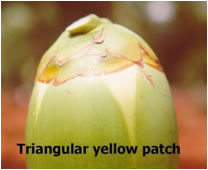 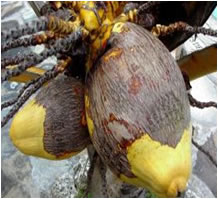 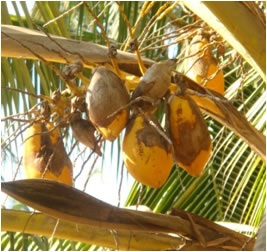 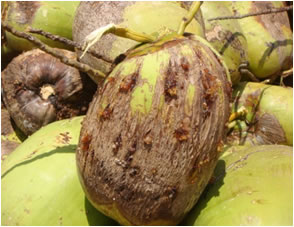 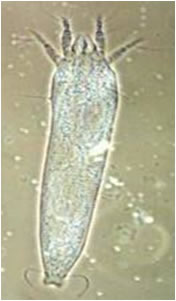 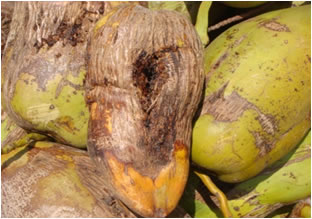 |
| Parts affected | Symptoms |
Management |
Image |
leaves, nuts and trunk
|
• Damages tender nuts by forming characteristic holes. • Shed nuts can be seen at the base of the palm. |
Mechanical Method:
|
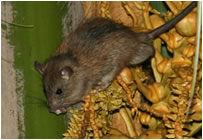 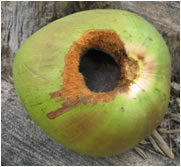 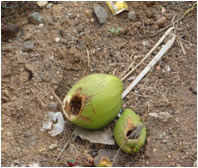 |
| Rat eating cocnut flower; fallen affected nut | |||
| Parts affected | Symptoms |
Management |
Image |
| Nuts | • Falling of damaged nut with holes |
|
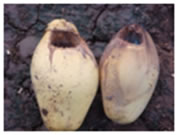 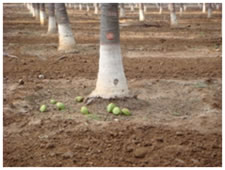 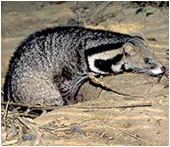 |
| Parts affected | Symptoms |
Management |
Image |
| leaves and roots | • Damage the roots of coconut. • Affected palms exhibit general decline, yellowing, button shedding, and reduction in leaf size. |
Biological Method:
Cultural Method:
|
 |
| Parts affected | Symptoms |
Management |
Image |
| Leaves, petioles, twigs, branches and fruits. | • Spear becomes pale and breaks at the base and hangs down. • Rotting slowly progresses downwards, finally affecting the meristem and killing the palms. This is accompanied by drooping of successive leaves. • Even then, nuts that are retained on the palm may grow to maturity. • The disease is fatal if not checked at the early stages, before damage of the bud. |
|
| Parts affected | Symptoms |
Management |
Image |
| leaves | • This disease is a fungal complex initiated predominantly by Colletotrichum gloeosporioides, Exserohilum rostratum and Fusarium spp. • Spear fails to unfurl when disease is acute. |
Physical Method:
Chemical Method:
|
    |
| Parts affected | Symptoms |
Management |
Image |
| leaves | • Minute yellow spots encircled by grayish bands appear on the surface of mature leaves of the outer whorl. • Later they become grayish white. These spots coalesce into irregular necrotic patches. • Complete drying and shriveling of the leaf blade at severe infection. |
Physical Method:
|
  |
| Parts affected | Symptoms |
Management |
Image |
| leaves | • Flowering is delayed and also yield is considerably reduced. • Tapering of terminal portion of the trunk. • Reduction of leaf size. • Abnormal bending or Ribbing of leaf lets termed as flaccidity. • The characteristic symptom is the droopiness of leaflets. • Yellowing of leaf tips to the middle of the leaves, necrosis of leaflets, • Deterioration and decay of root system • The leaflets curve inwardly to produce ribbing so that the whole frond develops a cup like appearance. • Abnormal shedding of buttons and immature nuts are also noticed. . |
Cultural Method:
|
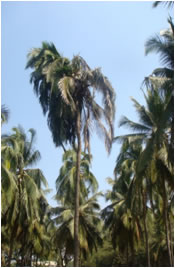 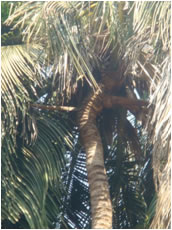 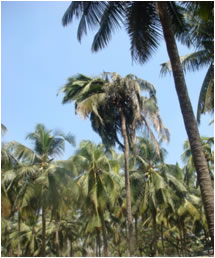 |
| Parts affected | Symptoms |
Management |
Image |
| leaves and trunk | • Exudation of a dark reddish brown liquid from the longitudinal cracks in the bark and wounds on the stem trickling down for a distance of several inches to several feet. • Lesions spread upwards as the disease progresses. • Liquid oozing dries up and turns black. • Tissues below the lesions become rotten and turn yellow first and later black. • In advanced cases, the interior of affected trunks are hollow due to decay of interior tissues. • As a result of extensive damage in the stem tissue, the outer whorl of the leaves turn yellow, dry and shed prematurely. • Production of bunches is affected adversely. The trunk gradually tapers at the apex and crown size becomes reduced in chronic cases. • Nut fall is also noticed. |
Cultural Method:
|
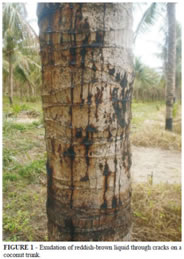 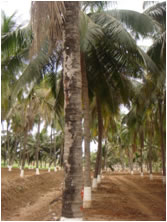 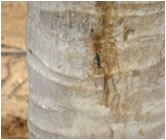 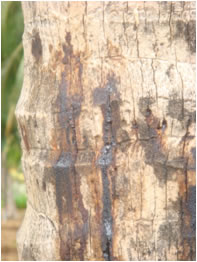 |
| Parts affected | Symptoms |
Management |
Image |
| trunk | •Withering, yellowing and drooping of the outer whorl of leaves. • This is followed by exudation of reddish brown liquid through cracks at the base of the trunk and oozing spread upward. Tissues on bleeding spots are soft to touch. • Decaying of tissues at bleeding point and rotting of basal portion of the stem • Bark turns brittle and often gets peeled off in flakes, leaving open cracks and crevices. The internal tissues are discoloured and disintegrated, emitting a bad smell. • Bracket formation at the base of the trunk. • Ganoderma appears at the base of the trunk. Ultimately the palm dies. |
Cultural Method:
Chemical Method:
|
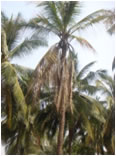 |
| Mature palm/tree |
| Parts affected | Symptoms |
Management |
Image |
| Trunk | • Wilting of seedlings • Roots eaten away by termites. |
Cultural Method: • Apply calcium at the base of the trunk for control of termite attack. • Swabbing with neem oil 5% once on the base and upto 2 m height of the trunk. |
  |
| Affected shoot and panicle | |||
 |
| Parts affected | Symptoms |
Management |
Image |
| leaves | • Dried up patches on leaflets of the lower leaves, only three or four youngest leaves at the center remain green. • Galleries of silk and frass on underside of leaflets. • Whole plantations present a scorched appearance in case of severe infestation. |
Cultural Method: Root feeding : • Secure the bag tightly to the root with a cotton thread. • After twenty four hours, check whether there is absorption or not. Select another root when there is no absobtion. This method should not be resorted to as a routine practice and it is suggested only for cases of severe epidemic outbreak of the pest and when the survival of the tree is threatened. Stem injection: |
  |
| Affected shoot and panicle | |||
     |
| Parts affected | Symptoms |
Management |
Image |
| leaves | • Leaves turn yellow. • Premature nut shedding. • Flowering delayed. • White grubs are exposed when base of the tree dug. |
Cultural method:
Mechanical Method:
Chemical Method:
|
| Parts affected | Symptoms |
Management |
Image |
| leaves | • Young larvae feed on the lower epidermis of the leaf. • As they mature, the whole leaf blade is eaten leaving the midribs. • In heavy infestation, the larvae may defoliate the palm. |
Mechanical Method:
|
    |
| Parts affected | Symptoms |
Management |
Image |
| leaves | • It feeds on plant sap. • Button mealy bugs colonize under the perianth lobes of tender nuts. Infested nuts harbouring gravid mealy bugs remain on the spadix, which serve as inoculum for further spread. |
Cultural Method:
Chemical Method: Spray any one of the following
|
   |
| Parts affected | Symptoms |
Management |
Image |
| leaves | • It occurs more in summer, it affects leaves and nuts of coconut palms. • At severe infestation, scale forms a continuous crust over flower spikes, young nuts and lower surface of leaves. • Yellow spots on leaves. • Entire leaves turn yellow to brown and falls. • Infested coconut fronds exhibit yellow areas on the upper surface, formed by numerous yellow spots each marking the position of the coconut scale on the under surface. Development of sooty mould. • Affected coconut palm turns bright yellow colour which is clearly visible from distance. • In extreme cases, the leaves dry out, entire fronds drop off and the crown dies. • Heavy infestation results in stunting of new leaves, reduction of crop yield or complete crop failure. |
Biological Method:
|
     |
| Scales on leaf and tender coconut | |||
| Parts affected | Symptoms |
Management |
Image |
| leaves | • The adult beetle bores into the unopened fronds and spathes. Damage by the pest leads to 10 to 15% loss in yield. • The attacked frond shows characteristic triangular cuts when fully opened. • Central spindle appears cut or toppled. • Fully opened fronds showing characteristic diamond shaped cuttings. • Holes with chewed fibre sticking out at the base of central spindle. |
Cultural Method:
Chemical Method:
|
       |
| Parts affected | Symptoms |
Management |
Image |
| Trunk | • Make holes on trunk and hole can be seen on the stem with chewed up fibres protruding out. • Oozing of reddish brown liquid from the hole. • The grubs cause damage inside the stem or crown by feeding on soft tissues and bore into the soft, growing parts. • Inside portion of trunk is completely eaten and become full of rotting fibres in case of severe infestation. • In case of young palms the top withers while in older palms the top portion of trunk bends and ultimately breaks at the bend (wilting). • Sometimes the gnawing sound produced by the feeding grubs inside will also be audible. • In the advanced stage of infestation yellowing of the inner whorl of leaves occur. The crowns falls down or dry up later when palm is dead. |
Cultural Method:
Trap Method:
Chemical Method:
|
        |
| Parts affected | Symptoms |
Management |
Image |
| Nuts | • The earliest symptom is pale yellow triangular patches seen below the perianth on 2-3 month old buttons and patches become brown. • As the buttons grow, brown patches lead to black necrotic lesions with longitudinal fissures on the husk. • Severely affected buttons fall from the tree. • Oozing of the gummy exudation from surface of affected nuts. •Uneven growth results in distortion and stunting of nuts leading to reduction in copra yield. • Nuts are malformed with cracks and hardened husk in severe cases. |
Cultural Method:
Chemical Method: Root Feeding:
Method of Application:
|
      |
| Parts affected | Symptoms |
Management |
Image |
| leaves, tree and nuts | • Damages tender nuts by forming characteristic holes. • Shed nuts can be seen at the base of the palm. |
Mechanical Method:
|
   |
| Rat eating cocnut flower; fallen affected nut | |||
| Parts affected | Symptoms |
Management |
Image |
| Nuts | • Falling of damaged nut with holes |
|
   |
| Parts affected | Symptoms |
Management |
Image |
| leaves | • Damage the roots of coconut. • Affected palms exhibit general decline, yellowing, button shedding, and reduction in leaf size. |
Biological Method:
Cultural Method:
|
 |
| Parts affected | Symptoms |
Management |
Image |
| Leaves, petioles, twigs, branches and fruits. | • Spear becomes pale and breaks at the base and hangs down. • Rotting slowly progresses downwards, finally affecting the meristem and killing the palms. This is accompanied by drooping of successive leaves. • Even then, nuts that are retained on the palm may grow to maturity. • The disease is fatal if not checked at the early stages, before damage of the bud. |
|
| Parts affected | Symptoms |
Management |
Image |
| Panicles, leaves and stem | • This disease is a fungal complex initiated predominantly by Colletotrichum gloeosporioides, Exserohilum rostratum and Fusarium spp. • Spear fails to unfurl when disease is acute. |
Physical Method:
Chemical Method:
|
    |
| Parts affected | Symptoms |
Management |
Image |
| Panicles, leaves and stem | • Minute yellow spots encircled by grayish bands appear on the surface of mature leaves of the outer whorl. • Later they become grayish white. These spots coalesce into irregular necrotic patches. • Complete drying and shriveling of the leaf blade at severe infection. |
Physical Method:
|
  |
| Parts affected | Symptoms |
Management |
Image |
| Panicles, leaves and stem | • Flowering is delayed and also yield is considerably reduced. • Tapering of terminal portion of the trunk. • Reduction of leaf size. • Abnormal bending or Ribbing of leaf lets termed as flaccidity. • The characteristic symptom is the droopiness of leaflets. • Yellowing of leaf tips to the middle of the leaves, necrosis of leaflets, • Deterioration and decay of root system • The leaflets curve inwardly to produce ribbing so that the whole frond develops a cup like appearance. • Abnormal shedding of buttons and immature nuts are also noticed. . |
Cultural Method:
|
   |
| Parts affected | Symptoms |
Management |
Image |
| Panicles, leaves and stem | • Exudation of a dark reddish brown liquid from the longitudinal cracks in the bark and wounds on the stem trickling down for a distance of several inches to several feet. • Lesions spread upwards as the disease progresses. • Liquid oozing dries up and turns black. • Tissues below the lesions become rotten and turn yellow first and later black. • In advanced cases, the interior of affected trunks are hollow due to decay of interior tissues. • As a result of extensive damage in the stem tissue, the outer whorl of the leaves turn yellow, dry and shed prematurely. • Production of bunches is affected adversely. The trunk gradually tapers at the apex and crown size becomes reduced in chronic cases. • Nut fall is also noticed. |
Cultural Method:
|
    |
| Parts affected | Symptoms |
Management |
Image |
| Panicles, leaves and stem | •Withering, yellowing and drooping of the outer whorl of leaves. • This is followed by exudation of reddish brown liquid through cracks at the base of the trunk and oozing spread upward. Tissues on bleeding spots are soft to touch. • Decaying of tissues at bleeding point and rotting of basal portion of the stem • Bark turns brittle and often gets peeled off in flakes, leaving open cracks and crevices. The internal tissues are discoloured and disintegrated, emitting a bad smell. • Bracket formation at the base of the trunk. • Ganoderma appears at the base of the trunk. Ultimately the palm dies. |
Cultural Method:
Chemical Method:
|
 |
![]()
Agro Advisory Service
Focus Districts
Gallery
